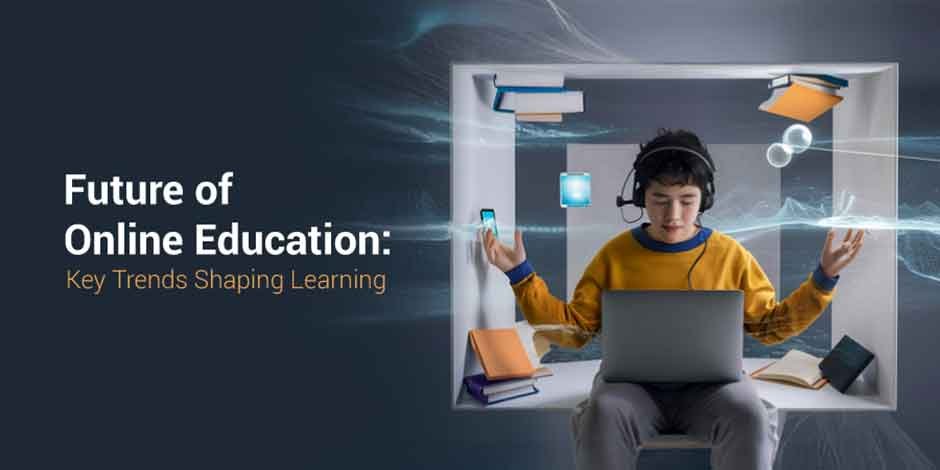Online education has become increasingly popular due to the convenience of learning from home and the flexibility to set one’s own schedule. Besides reaping these benefits, students can also access a vast array of courses from global institutions.
According to a report by Custom Market Insights, the global online education market is expected to reach USD 200 billion by 2030. This growth is a clear indication of the increasing demand for innovative and flexible learning solutions.
Despite this promising statistic, there is a key question: Will e-learning be the same as it was a few years back? Probably not.
The future of online education is unfolding rapidly, and it’s exciting to see how it’s reshaping the learning and teaching approaches. The key trends that are emerging, such as personalized learning, gamification, and the rise of AI, are not just enhancing the experience but also making learning more engaging and effective.
For online educators, these trends mean more ways to connect with students and customize lessons to individual needs. For students, it’s about gaining access to flexible, interactive, and immersive learning experiences that fit into their busy lives.
This blog explores the major trends driving this transformation, how they are shaping the future of online learning, and the challenges.
Top Innovations That Are Reshaping Online Education
Here are the powerful e-learning innovations driving the future:
1. Personalized Learning with AI
AI-powered learning personalizes the instructions to each student’s unique needs, abilities, and learning styles. This makes learning smarter and more effective.
For instance, AI-powered tools can analyze a student’s progress and adapt the learning path accordingly. Imagine a math student struggling with fractions. Instead of following a generic curriculum, AI can adjust the content, offering simpler explanations or extra practice sessions until the student masters the topic. This creates a customized learning journey that fits each student perfectly.
AI in online education enables teachers to focus on meaningful interactions by managing administrative tasks like grading, while adaptive platforms provide real-time feedback and suggest resources based on the student’s performance. As a result, educators can better address learning gaps and celebrate individual achievements.
A great example of this is Duolingo, an online learning platform that adapts lessons based on how well the user performs. If a learner consistently gets certain words wrong, the app will focus more on those words, reinforcing the learning process.
2. Rise of Microlearning and Modular Courses
Microlearning is becoming a go-to strategy for both educators and students. It focuses on delivering lessons in small parts rather than overwhelming students with long lectures. This method allows students to grasp one key idea at a time, making it easier to retain information and apply it in real-world scenarios.
A great example is LinkedIn Learning. It offers courses broken down into short, easy-to-follow videos that focus on specific skills. For instance, a user could take a 5-minute video on Excel shortcuts or spend 10 minutes learning how to craft a professional email. This flexibility allows learners to improve their skills quickly without committing to long hours of study.
For educators, modular learning offers more control over content delivery. They can update a single module or introduce a new topic without disrupting the whole course. This also lets students focus on the areas they need the most help with. With microlearning, education becomes more dynamic, effective, and easier to manage, benefiting both learners and instructors alike.
3. Gamification and Interactive Learning
As the name suggests, gamification brings the excitement of games into the learning process, making lessons more engaging and motivating students to participate actively. When educators incorporate game-like elements like points, badges, and leaderboards, students feel a sense of achievement with every step they take. It’s no longer just about completing tasks; it’s about competing, winning, and improving.
For example, Classcraft is a platform that turns the classroom into a role-playing game where learners gain points for completing tasks, collaborating with classmates, and demonstrating positive behavior. The more points they accumulate, the more power they gain within the game, which boosts motivation.
For students, the sense of achievement and progress from gamification can increase their motivation and make learning feel less like a chore. It turns studying into an exciting challenge where students feel like they are progressing, not just ticking off tasks.
4. Virtual and Augmented Reality (VR/AR) in Education
Virtual and Augmented Reality (VR/AR) technologies bring intricate concepts to life that traditional educational methods cannot, thereby providing immersive learning experiences. Imagine exploring ancient Egypt in 3D or practicing surgery in a virtual operating room; these are real examples of how VR is being used in education today.
For educators, VR/AR can create more engaging and interactive lessons. Instead of just reading about historical events or studying biology from a textbook, students can experience these subjects firsthand. This kind of learning makes information stick better and keeps students motivated.
Students, on the other hand, can benefit from a more hands-on approach. For example, a medical student can perform virtual surgeries, gaining practical skills without risk. Or, language learners can immerse themselves in virtual environments that mimic real-life scenarios, enhancing their conversational skills.
Besides making the learning process more exciting, these advanced technologies can also bridge gaps in accessibility. VR/AR brings experiences to students who may not have the opportunity to visit museums, labs, or other important learning spaces.
5. The Shift to Lifelong Learning and Skill Development
With the rapid pace of change in technology and the job market, both students and professionals must continuously update their skills and enhance their knowledge to stay relevant. This shift is particularly visible in online education, where learners of all ages can access resources to upskill or reskill based on their personal or career goals.
The courses offered by online learning platforms should be designed not just to teach but to help learners acquire practical skills. For example, platforms like Coursera and Udemy have introduced skill development courses in fields like data science, digital marketing, and AI, helping people transition to new industries.
This skill-based learning empowers students to move beyond traditional degree programs and develop specific competencies, enhancing their employability.
6. The Growing Role of Social Learning and Collaboration
Social learning is changing how students and educators interact online. It’s not just about watching a video or going through a textbook anymore. Today, online education thrives on collaboration; students learn by discussing ideas, sharing resources, and working together on projects.
Platforms like forums, group chats, and online study groups help students connect, share insights, and solve problems together. On the other hand, teachers can facilitate conversations and encourage peer learning rather than delivering content in isolation.
Take, for example, an online coding course. When students collaborate on coding challenges or participate in live discussion sessions, they grasp concepts better. The shared experience not only makes learning more enjoyable but also helps students learn from each other’s mistakes and successes.
At the same time, creating a collaborative environment helps build a community of learners. It transforms educators’ role from just teaching to mentoring, guiding students through discussions, and helping them apply their knowledge.
7. Mobile Learning and Accessibility
With smartphones becoming a staple in students’ lives, mobile learning offers a flexible approach for both educators and learners. Whether it’s revising lessons during commute or accessing course materials on the go, mobile learning breaks the limitations of traditional classrooms.
For students, the ability to learn anytime and anywhere is convenient in absolute terms. Imagine revising for an exam on a train ride, or even completing assignments while waiting in a café.
Mobile learning allows educators to provide real-time feedback and interaction. Mobile platforms like Google Classroom or Edmodo help teachers stay connected with their students, track their progress, and engage them through instant notifications.
Also, students with disabilities, such as visual impairments, benefit greatly from apps that include voice recognition and text-to-speech features, ensuring everyone has equal access to learning. For instance, a visually impaired student can use the VoiceOver feature on an iPhone to navigate through a learning app.
8. Blockchain Technology for Credentialing and Security
Blockchain is making waves in online education by transforming how credentials are verified and managed. Imagine a world where your degree or certificate is tamper-proof and instantly verifiable by anyone; this is the promise of blockchain. With its decentralized system, blockchain ensures that your academic credentials are secure, transparent, and can’t be altered once issued.
Online educators don’t have to worry about fake certificates anymore, thanks to blockchain technology. Blockchain allows institutions to issue verified, digital credentials that students can share directly with employers or other schools, with just a click. There’s no need for lengthy background checks or delays; the credentials speak for themselves.
For instance, MIT is already exploring blockchain to issue secure digital diplomas, giving students a hassle-free way to prove their qualifications.
Students benefit from blockchain by having control over their educational records. Whether it’s a course completion certificate or a degree, they can store and share their credentials securely. Employers also trust blockchain-powered certificates because they know they can’t be forged.
Challenges and Considerations of Online Education
While the future of e-learning holds immense potential, there are several challenges that both educators and students must address. Let’s take a closer look at some key considerations:
a) Technological Barriers: Not every student or educator has stable internet access or the right devices for online learning or imparting education. This creates challenges for both learning and teaching, especially in remote or underserved areas.
b) Engagement and Motivation: Online learning can feel isolating. Students may struggle to stay motivated without the classroom dynamic. Keeping learners engaged through screens can be difficult for educators, especially when distractions are high.
c) Quality Assurance: The rise of online courses means there are plenty of options, but not all courses meet high standards. Ensuring quality content, preventing cheating, and delivering real value can be a challenge for teachers.
d) Instructor Training: Educators may find it tough to switch from traditional methods to online platforms. Therefore, it’s crucial to train teachers in using digital tools to create engaging and effective online lessons.
e) Digital Divide: Access to technology often depends on socioeconomic factors. Students from lower-income backgrounds may face difficulties in accessing online courses, making it harder to bridge the gap in education.
Conclusion
The future of online education is bright, with several exciting trends paving the way for more personalized, accessible, and engaging learning experiences. From customized learning with AI to blockchain technology, the possibilities are endless.
As educators and students, it’s crucial to stay adaptable and accept these changes. However, challenges like ensuring quality and access remain. Whatever it is, both educators and students must explore innovative learning tools and stay open to new methods to create a more inclusive and effective learning environment.






